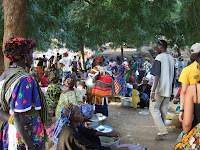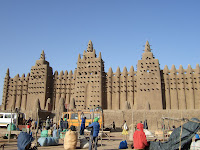
When we last left, we had spent a chilly night on the top of a roof in Timbuktoo. Well, lets us be on our way now to Essakane, about 60 miles norht of Timbuktoo, it is on the very last outskirts of scrub land before the vastness of the Sahara desert takes over. Regardless, most of the driving is through desert sands, which are extremely silky soft sand that makes drving fast and reckless, based on how our driver drove.
Anyway, we spent two nights three days sleeping in a traditional animal skin open tent on the sand. There were a few thousand people there, alot of international people, but moslty Malians and venders selling alot of art stuff. Amazingly, no matter who you went up to, they all had a good price, and sometimes there name was Mr Good Price. I met alot of Mr Good Prices in my travels. Anywho, there was music only at night, abd during the day with the sun blazing, people either slept or wandered around the festival sands, either looking at wares to buy, seeing the random music and dancing, or talking to a guy who is mkaing efficent stoves for refugess using recycling packaginig material.
We left the festival early on the third day so we could be on our way back to Mopti. We covered all the same bumpy, dusty, silky smooth terrain we had on the way there, and again it took us about 12 hours this time to return. In Timbuktoo we got a flat and waited 30 minutes to fix it, at one of the checkpoints where the army checks papers, we waited 30 minutes. All in all, we got back to Mopti, crashed on the dingy floor we had slept on last time in town, and planned to be on our way to Dogon Country, or Pays Dogon in french, in the morning.
And so it happened. We left Mopti and made our way to Bandgira, which is the captical of the area. From there, we took a different car into the Dogon area and then started hiking. I dont have my notes in front of me, but we hiked to four different towns. The first was on the top of the escarpment. Oh, the Dogon country is bascially a huge escarpment with the majority of villages at the bottom of the escarpment. If you dont know what an escarpment is, i suggest a google search. Anywho, form the first village we hiked down, at first through a nice green tree area, and then on the bottom it opens out as the area had once been forested with wild animals and water, but when the Dogon came to the area, they forced the natives, the Tellem, into the upper areas, cut down the trees, killed the animals, and lo, now there are no animals, limited trees, and no major running water. There is some irrigation going on and therefore there are awesome islands of waving green onion tops, as the Dogon love there onion. Anywho...
We went to the next village, simlar in some aspects as the houses are all mud with wooden supports. There are graneries for men and women for each household. Some Dogon are still Animist while others are Muslim. The women make millet beer, sell it to the men, and make some money. Not many people drink. The millter beer wasnt bad, but wasnt a Brooklyn Dark if you know what i mean.
From this town we took an ox driven cart to the next. An ox driven cart sounds all nice and safe, but at times we almost fell off, and the driver kept whipping the ox as he liked to walk at this pace, which the driver did not seem to like. Regardless, we got to our last village, ate some rice wiht tomato sauce, i really like the tomatao sauce, and slept inside for once in a nice mud room. For a little while, i stayed on the roof as it was warm and the stars are bright and nice.
The enxt day, it was back to Mopti and then on to Seqou, where we spent two kinda lazy days, in this kinda lazy quiet town. Much different than Mopti, no major water ports, people arent trying to sell you lots of things, just a ncie quiet little place. We saw amazing music at night in a bar, it was all traditional with three types of Malian drums and a large wooden xylophone, with calabashes underneath to make the sound. The guy playing was phenominal, he played so fast you couldnt see his hands, then he picked up the djemebe and played super fast too. It was great, people were up and dancing all over the place, and i had a few of the queens of beers in the prcoess.
We finally made our way back to Bamako, and back to the Mission Catholque where i slept outside on the couch, once without mosiquite net which was a mistake and the second night with. Bamako is a bustling capital, mcuh different from Praia, and from what i am told much different from other afrikan captials. It was safe, croweded all over the palce with cars and people and vendors and people cooking and people selling dried monkey heads and peanuts and all types of stuff. never ending movement, it was greta and a bit overwhelming at the same time. We spent alot of time at our faviroit hangout across form the Mission, Mohameds vegetarian resturant. good food, good guy, and good kitten.
And so, we headed back to Cape Verde, spent five days in Praia thanks to the wonderfulness of TACV, and eventually i settled back in Sao Nicolau and got my creole back.
I ruchsed this a bit as i wanted to finish up this Mali adventure. Watch out for the next installment on this blog entitled `Why are peanuts so funny?
